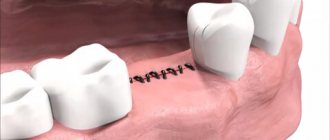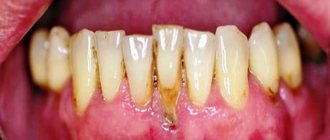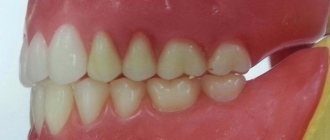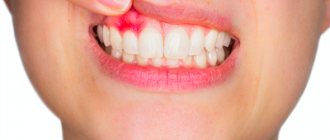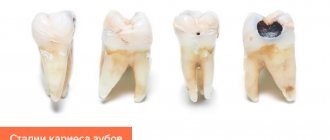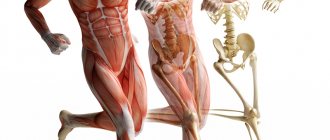21.07.2021
Author: Dentist-periodontist, therapist Stopinskaya Ulyana Yurievna
Modern dentistry is impossible without reconstructive surgical interventions. Almost all of our patients undergoing dental rehabilitation have encountered one type of surgical treatment or another: implantation, closing recessions, replanting grafts, etc. The success of such treatment depends on many factors. We will look at some of them in more detail.
To begin with, it should be noted that for quick and high-quality healing, the doctor must meet the following conditions:
- Healing by primary intention (bringing together the edges of the wound with sutures). Wound healing refers to all the physiological and regenerative processes that occur when restoring the integrity of damaged tissues. Surgical wounds are created under relatively controlled conditions, i.e. The surgeon can influence certain factors to a certain extent, for example, the type of incision, the method of creating the flap, the width of the receiving bed, and the method of suturing.
The photo shows a view of the wound on the 14th day after surgery. The seams are visible. Healing by primary intention.
- Good blood supply to the intervention area . The difficulty of healing after implantation or plastic periodontal surgery is often due to the fact that the wound is located in the projection of the surface of the tooth or implant, which does not contain blood vessels. This reduces local immunity and makes it difficult to deliver nutrients.
- Cleanliness in the intervention area. The oral cavity is colonized by a large number of bacteria that can directly affect wound healing. The doctor must ensure that on the eve of the operation the patient undergoes professional hygiene and is trained in postoperative oral care.
The photo shows the view before and after professional hygiene
Now let's take a closer look at the factors influencing wound healing. They can be divided into general and local.
Causes of sores in the mouth
Purulent ulcers in the mouth can appear for various reasons. They are often the result of dental diseases.
The list of reasons may include the following:
- viral infections (herpes simplex or herpes zoster);
- fungal and bacterial infections;
- irritation of the mucous membranes from smoking and certain foods (nuts, cheese, citrus fruits);
- ulcerative stomatitis;
- chemotherapy drugs;
- frequent stress and nervous tension;
- oral injuries;
- hormonal changes.
The occurrence of ulcers due to diseases/damage to the soft tissues of the mouth and tongue
1. Recurrent
aphthous stomatitis is a chronic inflammatory disease that is characterized by periodic eruptions of aphthae (small ulcerations) on the oral mucosa. Aphthae can be localized on the tongue, buccal mucosa, hard and soft palate, and also on the mucous membrane of the lips. They are painful. In some cases, with constant injury, aphtha can turn into a long-term non-healing ulcer, after epithelization of which a scar is formed.
Patients with recurrent aphthous stomatitis usually suffer from colitis. Nervous strain, minor injuries to the mucous membrane, for example, when brushing teeth, as well as menstruation, can also predispose to the onset of the disease. The aphtha heals within 7 - 10 days. In case of complications of the disease, the number of ulcerations may increase, then the healing period is extended by 2 - 4 weeks.
2. Herpetiform stomatitis
characterized by the appearance of numerous small ulcers. In appearance they resemble the sores of herpes simplex. As a rule, they occur in women under 30 years of age. They are localized mainly on the lower surface of the tongue and in the area of the floor of the mouth. They do not have clear boundaries, the base is gray. The healing process is completed largely without scarring within 7 to 10 days. In simple forms of stomatitis, white ulcers in the mouth are observed (or rather, the center of the ulcer is covered with a thin, loosely fitting white or grayish film). Also, a white ulcer in the mouth can form in children in cases where there is candidal, or fungal, stomatitis.
As for the treatment of stomatitis, in this case the form of the disease and the severity of the lesion are taken into account. General and local treatment depends on this. But for almost all forms of stomatitis, vitamin C is prescribed to improve immunity.
3. Recurrent necrotizing peryadenitis
(Setton's aphthae) is characterized by the formation of a compaction in the submucosa, then painful ulcers with raised and compacted edges form in this place, as well as the presence of an inflammatory infiltrate (accumulation of cellular elements mixed with blood and lymph). Ulcers are localized on the upper and lower lips, cheeks, and lateral surfaces of the tongue. Eating food becomes extremely difficult for many patients, even to the point of giving it up. The same severe pain can be observed when talking. The ulcers do not heal until several months, and the disease lasts for years.
4. Afty Bednar
occur exclusively in children and are defined as traumatic erosions (ulcerations). The cause is poor oral hygiene or rough mechanical rubbing of the mucous membrane of the palate (this is where they are located). Covered with a whitish-yellow coating.
5. Traumatic ulcer
in the mouth is most often the result of physical impact, hence its name. As a rule, such an ulcer occurs as a result of an accidental or intentional bite of the mucous membrane, damage by a toothbrush. The presence of a traumatic ulcer in the oral cavity can provoke dental treatment (with careless use of dental instruments or, for example, with pointed temporary crowns).
Also among traumatic ulcers are the so-called prosthetic ulcers, which arise from exposure to complete or partial removable dentures, the dimensions of which are larger than necessary, or their surface is poorly processed and has sharp edges. Such ulcers can be located directly under the prosthetic structure. As a rule, healing takes place within 10 - 14 days, provided that the traumatic factor is eliminated. Treatment may not be necessary, since traumatic ulcers are often painless and small in size. In the case of the opposite, antimicrobial and anti-inflammatory drugs are prescribed, and the use of an ultrasonic brush is recommended, which not only cleans, but also has an antibacterial effect.
Also, the presence of ulcers can be caused by the effects of alkalis, acids, and certain medications on the oral mucosa.
How can you get rid of sores in your mouth?
How to treat wounds in the mouth if they appear and cause discomfort. Initially, you need to determine the true causes of their occurrence. This will help not only choose the right treatment, but also reduce the risk of relapse. If simply stomatitis has formed, it is not difficult to recognize it, but a purulent wound in the mouth of unknown pathogenesis is a reason to consult a doctor. Particular attention should be paid to lesions that do not heal for more than 10 days.
For a quick recovery, use:
- medicinal ointments with anti-inflammatory effect;
- antibiotics if the cause is a bacterial infection;
- complex of vitamins;
- rinsing with oral antiseptics;
- protective applications;
- painkiller injections;
- laser cauterization.
Ulcers as local manifestations of general diseases on the oral mucosa
- Oral tuberculosis
is usually a secondary manifestation of pulmonary tuberculosis. It occurs as a result of penetration of tuberculosis bacteria into the oral mucosa through damaged epithelium. The membranes of the cheeks, tongue, and floor of the mouth are affected. First, typical tuberculous tubercles are formed, and then, after their disintegration, small ulcers are formed, which increase in size over time. The ulcer itself is not deep, with a loose bottom, which is covered with easily bleeding granulations (young tissue), uneven edges are observed, soft to the touch. With this disease, there is a sharp pain in the ulcer. In addition to the local manifestation in the form of an ulcer, there is a general deterioration in the well-being of patients: emaciation is noted, the amount of plaque on the tongue increases, sweating and body temperature increase. General treatment of tuberculosis of the oral mucosa is carried out in specialized anti-tuberculosis institutions. As for local treatment, in this case, sanitation of the oral cavity is carried out during the period of remission (weakening of the disease), treatment of the mucous membrane with antiseptic and anti-inflammatory agents. - Syphilis
is a chronic infectious disease caused by the so-called Treponema pallidum. All periods of development of this disease (in addition to the incubation period, which lasts 21 - 24 days) are characterized by the presence of ulcers in the oral cavity. At the initial stage of development of the disease, the presence of a painless ulcer is observed, which has a round or oval shape with raised, smooth edges and a cartilage-like specific infiltrate. The bottom of the ulcer is bright red, shiny or covered with a grayish-dark coating. The ulcers heal in 3 to 12 weeks with or without scar formation. Even with tertiary syphilis, there is no sharp pain, as, for example, with a tuberculous ulcer. The ulcer is surrounded by a powerful infiltrate, which is a dense bluish-red ridge that rises above the level of the mucosa. Its edges are smooth, bright red, covered with granulations, and bleed easily. After the ulcer heals, a retracted star-shaped scar forms. This process lasts 3 - 4 months. After the ulcers heal, scars remain, which are a sign of previous syphilis. General treatment of syphilis is carried out in a venereology hospital, local treatment is carried out during the period of remission or recovery (sanitation of the oral cavity, elimination of local traumatic factors). - Acute necrotizing gingivostomatitis
is a viral infectious disease. Most often, ulcers are localized on the mucous membranes of the gums, cheeks, soft palate, arches and tonsils. Favorable factors for the development of this disease are a decrease in the overall resistance of the body, a violation of the integrity of the oral mucosa, and a deficiency of vitamins in the body. There are also cases of this disease occurring against the background of cooling or overwork. It can also be a complication of viral infections, as well as allergic stomatitis. Usually young people (under 30 years of age) are affected, more often men.
Among the symptoms it is necessary to highlight: pain when eating; extremely unpleasant odor from the mouth; increased salivation; elevated body temperature. The gum mucosa becomes swollen, painful, and bleeds when touched. The epithelium of the gingival margin and gingival papillae becomes cloudy. The surface of the gingival margin is covered with a grayish-yellow coating, which is easily removed. The ulcers have soft, uneven edges and are covered with a dirty green coating (with a foul odor), which is easily removed. In this case, a loose bleeding bottom is detected. The surrounding tissues are swollen.
Treatment of necrotizing gingivostomatitis is carried out in accordance with the general condition of the body, taking into account its location and severity of the lesion. In moderate and severe stages of the disease, broad-spectrum antibiotics are prescribed, as well as drugs that prevent or reduce the manifestation of allergies. At any stage of development of the disease, vitamins C and P, high-calorie foods, juices are prescribed, and in some cases, according to indications, taking cardiac medications.
Local treatment is carried out under anesthesia (removal of necrotic tissue). The oral cavity is treated with warm solutions of antiseptics and anti-inflammatory drugs. The ulcer is also sprinkled with white clay powder. After acute inflammation has been relieved, professional oral hygiene is carried out.
Mouth ulcers can also form due to HIV (gum ulceration occurs in approximately 30% of people infected with HIV). How to cure mouth ulcers in this case? Treatment is specific and carried out by infectious disease doctors. Dental care is provided in all dental institutions with careful adherence to safety precautions.
Prevention of all of the above oral diseases consists of eliminating the causes of their occurrence. For example, to prevent infectious diseases that manifest themselves on the oral mucosa, such as syphilis, measures are necessary that prevent infection from entering the body. In other cases, wellness measures are very important, which include systematic independent and professional oral hygiene, which is offered by almost all dental clinics in Moscow.
Traumatic mouth ulcers
The name of traumatic ulcers speaks for itself. This is the appearance of wounds in the oral cavity due to injury to the mucous membrane. The causes of injury may be:
- Bite of the mucous membrane;
- Accidental contact with a toothbrush;
- Inaccurate dental treatment.
One of the types of traumatic ulcers are prosthetic ulcers - wounds formed due to incorrect sizes of removable dentures. They are localized precisely under the dentures.
Healing of traumatic ulcers lasts 1-2 weeks. As a rule, this is a one-time pathology that goes away on its own without additional treatment. Such aphthae are painless and small in size.
If a complication of the disease nevertheless begins, it is necessary to visit a doctor so that he can prescribe anti-inflammatory and antibacterial medications to completely eliminate the pathology.
White ulcer on the oral mucosa: how to deal with the problem
White sores in the mouth appear quite often. Although the problem cannot be called critical, it causes significant discomfort. Difficulty talking, chewing, swallowing and smiling. In some cases there is pain. Therefore, everyone who has ulcerative formations wants to get rid of them as quickly as possible. In this case, you cannot self-medicate. To determine the cause of the ulcers and prescribe effective therapy, it is necessary to undergo examination by a specialist.
Afty Bednar
Bednar's aphthae is the appearance of small wounds on the oral mucosa. The pathology manifests itself exclusively in children due to poor hygiene or accidental injury.
The location of the ulcers is the palate. They have a slightly yellowish coating and heal quite quickly - up to 5 days. For the pathology to go away, it is enough to normalize oral hygiene.
The gums become inflamed due to insufficient oral hygiene and lack of regular visits to the dentist. The result is an excessive accumulation of plaque on the teeth and pathogenic microorganisms. Pathogenic microorganisms trigger a process in which their own toxins and inflammatory mediators are generated. Treatment of diseases of the mucous membranes and gums with the Vector device
